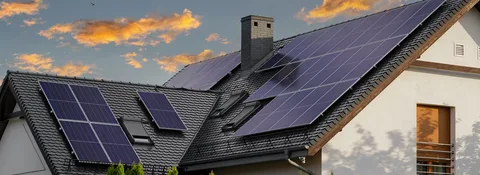How Solar Energy is Driving the Green Revolution in Britain
A sustainable path forward
The UK is at the forefront of the global green technology revolution, adopting innovative solutions to combat climate change and transition to sustainable energy. A key component of this shift is solar energy. Despite the UK’s reputation for cloudy skies, advancements in solar technology are proving that harnessing sunlight is a viable and valuable resource. This article explores how the UK is maximising solar energy, the regions in Europe best suited for green energy, and how to optimise production year-round.
How much sunlight is really enough in the ?
The UK’s best months for sunlight are from April to September, with longer daylight hours and increased solar radiation. On average, the UK receives about 1,000-1,200 kWh per square metre annually, making solar panels a practical option even in less sunny regions.
Peak solar energy from a 1kW system
A 1kW solar panel system can produce approximately 850-1,100 kWh of electricity per year in the UK, depending on location and weather conditions. During the peak summer months, this can equate to about 3-5 kWh per day. While this may seem modest compared to sunnier countries, advancements in solar technology and efficient panel designs are optimising output.

Which areas in Europe are best for greenlight energy?
When comparing solar potential, Europe has a diverse range of suitable locations for greenlight (solar) energy.
Best regions in Europe for solar energy:
- Southern Europe:
- Countries like Spain, Italy, and Greece receive 2,000-2,300 kWh per square metre annually, making them solar powerhouses.
- Central Europe:
- Germany and the Netherlands, despite moderate sunlight, are leaders in solar adoption due to high efficiency and policy support.
- UK hotspots:
- The south of England (e.g., Cornwall, Devon) has some of the best solar potential in the UK, with higher annual sunlight hours compared to northern regions.
- Coastal areas and countryside locations often perform better due to fewer shading obstacles.
How to optimise solar energy production during warmer months
The warmer months offer the best conditions for solar energy production, but maximising efficiency requires strategic planning and maintenance.
Solutions for optimising summer solar production:
- Panel positioning and angle:
- Solar panels should be tilted at an angle of 30-40 degrees to maximise exposure to sunlight in the UK.
- Ensuring panels face south increases energy capture throughout the day.
- Use of solar trackers:
- Solar tracking systems adjust the orientation of panels to follow the sun’s path, increasing efficiency by up to 30%.
- Energy storage systems:
- Installing battery systems allows excess energy generated during sunny months to be stored and used during cloudy days or at night.
- Regular cleaning and maintenance:
- Dust, bird droppings, and debris can reduce panel efficiency. Cleaning panels every 1-3 months ensures maximum performance.

Can solar panels produce energy in winter?
Contrary to popular belief, solar panels can still produce energy during the winter months. Although shorter daylight hours and lower solar radiation reduce output, solar technology can function even on cloudy days.
Factors enabling winter energy production:
- Cold efficiency:
- Solar panels are more efficient in colder temperatures. Excessive heat in summer can reduce panel efficiency, whereas winter’s cooler climate ensures optimal performance.
- Sunlight availability:
- Even in the UK’s winter months, solar panels can capture diffuse sunlight, producing around 20-30% of summer output.
- Battery storage:
- Batteries can store surplus energy generated in warmer months, ensuring power availability in winter.
Solutions to maximise solar energy in winter
To maintain a steady energy supply during winter, it’s essential to adapt strategies for maximising output and mitigating challenges.
Tips for winter energy production:
- Install high-efficiency panels:
- Modern panels with advanced technology can capture more energy in low-light conditions. Look for panels with higher efficiency ratings.
- Energy storage upgrades:
- Larger battery systems ensure that energy collected during summer can power homes and businesses in the winter.
- Hybrid systems:
- Combining solar with other renewable sources, like wind or biomass, ensures consistent energy supply during less sunny months.
- Optimised tilt angle:
- Adjusting the tilt angle of panels to 15-20 degrees in winter can increase exposure to low-angle sunlight.

How to protect solar panels from winter damage
Winter can pose risks to solar panels due to snow, ice, and debris. Proper care and protection are crucial to ensure longevity and performance.
Best practices for winter solar panel care:
- Use snow guards:
- Installing snow guards or mesh prevents heavy snow accumulation and reduces strain on panels.
- Regular inspections:
- Check for cracks or damages caused by freezing temperatures and repair any issues promptly.
- Anti-reflective coatings:
- Coating panels with anti-reflective and hydrophobic materials prevents snow and ice from sticking.
- Heating elements:
- Some advanced systems include built-in heating elements that melt snow and ice without manual intervention.
- Ground-mounted systems:
- In areas with heavy snowfall, ground-mounted panels are easier to access and clear than rooftop installations.
The future of solar energy in the UK
As the UK continues to embrace green technology, solar energy is expected to play a pivotal role in reducing carbon emissions and achieving net-zero targets. Innovations like bifacial panels (which capture sunlight on both sides) and perovskite cells are set to boost efficiency even further. Additionally, government incentives and subsidies make solar adoption increasingly accessible for businesses and homeowners.
Conclusion: Leading the green revolution
Despite its reputation for cloudy skies, the UK is proving that solar energy is not only feasible but a critical component of its green revolution. By strategically optimising solar panel systems, leveraging modern technology, and adopting best practices for year-round efficiency, Britain is demonstrating how innovation and determination can overcome environmental challenges.
As the UK continues to invest in green tech, solar energy will remain a cornerstone of its journey toward a more sustainable and energy-independent future. Whether through maximising summer production, preparing for winter resilience, or protecting panels from damage, the UK’s efforts are lighting the way for the rest of Europe and beyond.




Post Comment